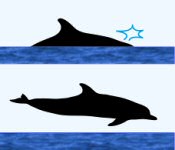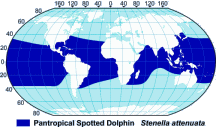Pantropical Spotted Dolphin
CLASS: Mammalia
ORDER: Cetacea
SUBORDER: Odontoceti
FAMILY: Delphinidae
GENUS: Stenella
SPECIES: attenuata
For reasons we don't yet understand, in the eastern tropical Pacific the spotted dolphin swims with yellowfin tuna. In the early 1960's, fishing for yellowfin tuna by hook and line was replaced by mile-long purse seine nets, and fishermen began "setting on dolphin" to catch the tuna. Historically, millions of dolphins have been killed in the purse seine tuna fishery, with the spotted dolphin accounting for 80% of the casualties. There are still two to four million spotted dolphins in the eastern tropical Pacific population, but no species can endure such massive losses indefinitely-hopefully the current trend of reducing the by-catch will continue.
Physical Description
Spotted dolphins are difficult to describe because their size and coloring vary according to their geographic location. Found only in tropical waters, and subtropical waters, there are two recognized species: the worldwide species, the pantropical spotted dolphin, Stella attenuata and the Atlantic species, Stenella frontalis. The spotted dolphin's body is covered with spots and becomes more densely spotted with age. In the eastern Pacific, coastal forms are the most heavily spotted, while those found in the Hawai'ian Islands and in Japanese waters and the eastern Indian Ocean have moderate spotting. The spotted dolphin has a long slim beak containing 35 to 48 small conical teeth in each side of the upper jaw and 34 to 47 small, conical teeth in each side of the lower jaw.

Surface Characteristics
Color
Color varies according to geographical location, age, and the individual. Generally speaking, these animals go through five color phases:
- newborn calves are dark gray with a white belly and no spots
- the color changes to two-tone, sharply divided, dark on top, light on belly and no spots
- adolescent phase when dark spots begin to appear on the lower part of the body
- light spots appear on the dark upper portion of the body
- dark ventral (underside) spots merge almost into a solid color with pink shading on the forward part of the belly
Fins and Fluke
Its beak is black and the lips and tip of the beak are white. A dark link extends from the middle of the lower jaw to the flipper and both eyes are circled in black with a black connecting line from each eye across the beak.
The dorsal (top) fin is tall and curved; the flippers are small and pointed. The flukes are small and pointed at the tips with a small median notch.
Length and Weight
Length averages about 7 feet (2.1 m); weight averages 220 pounds (100 kg). Calves are 32 to 36 inches (80 to 90 cm) at birth.
Feeding
Spotted dolphins feed on many varieties of fish and squid found near the surface of the water. In the eastern Pacific, pregnant females feed more on squid and nursing females tend to feed more on fish. The reason for this is unknown.
Mating and Breeding
This species reaches maturity between 6 and 8 years of age or when the animal is about 6.5 feet (2 m) in length. Mating and calving take place throughout the year; the calving interval is believed to be about every two years, but in stressed populations mating takes place at an earlier age and calving at shorter intervals, a response to the enormous mortalities suffered from being entangled in nets by the tuna fishery. Gestation is 11 1/2 months and calves are nursed for 11 months.

Range Map
Distribution and Migration
This species reaches maturity between 6 and 8 years of age or when the animal is about 6.5 feet (2 m) in length. Mating and calving take place throughout the year; the calving interval is believed to be about every two years, but in stressed populations mating takes place at an earlier age and calving at shorter intervals, a response to the enormous mortalities suffered from being entangled in nets by the tuna fishery. Gestation is 11 1/2 months and calves are nursed for 11 months.
Natural History
These animals are highly social and are sometimes found in herds of thousands, especially in offshore forms, though groups of several hundred are more common. Herds contain both sexes and all ages. Pantropical spotted dolphins are often seen in the company of other dolphin species, particularly spinner dolphins.
Status
The spotted dolphin is the species, which has suffered the most in the incidental take in the purse seine nets of the tuna fishery. From 1959 to 1978, it has been estimated that over 4,000,000 spotted dolphins dies in tuna nets. For reasons unknown, yellowfin tuna and spotted dolphins travel together in the eastern tropical Pacific, an area that extends from Mexico south to Chile and west to Hawai'i and Samoa. One theory is that they feed on the same food but at different levels. Tuna fishermen watch for the dolphins, then set their nets and encircle both dolphins and tuna, killing dolphins in the process. In 1972 the Marine Mammal Protection Act was passed and through improved fishing techniques and the required practice of having government observers aboard the tuna boats to monitor the number of dolphins killed, the mortality rate dropped to about 20,000 a year in the U.S. fleet. However, these rules do not apply to foreign tuna fleets and many dolphins die each year in some unregulated fisheries. In addition, several thousand are killed each year for food in drive fisheries in Japan.
Bibliography
- Jefferson, T.A., M.A. Webber, R.L. Pitman. 2015 Marine Mammals of the World: A Comprehensive Guide to Their Identification, 2nd Edition. Elsevier/AP.
- Leatherwood, S. and R. Reeves Whales and Dolphins San Francisco: Sierra Club Books, 1983.
- Leatherwood, S., R. Reeves, W. Perrin and W. Evans. Whales, Dolphins and Porpoises of the Eastern North Pacific and Adjacent Arctic Waters. U. S. Dept. of Commerce: NOAA Technical Report, NMFS Circular 444, July 1982.
Acknowledgements
- Illustrations courtesy Uko Gorter, copyright ©2017 all rights reserved.
FACT SHEETS MAY BE REPRINTED FOR EDUCATIONAL OR SCIENTIFIC PURPOSES
|



